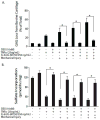Intra-articular dexamethasone to inhibit the development of post-traumatic osteoarthritis
- PMID: 27176565
- PMCID: PMC5604325
- DOI: 10.1002/jor.23295
Intra-articular dexamethasone to inhibit the development of post-traumatic osteoarthritis
Abstract
Injury to the joint provokes a number of local pathophysiological changes, including synthesis of inflammatory cytokines, death of chondrocytes, breakdown of the extra-cellular matrix of cartilage, and reduced synthesis of matrix macromolecules. These processes combine to engender the subsequent development of post-traumatic osteoarthritis (PTOA). To prevent this from happening, it is necessary to inhibit these disparate responses to injury; given their heterogeneity, this is challenging. However, dexamethasone has the necessary pleiotropic properties required of a drug for this purpose. Using in vitro models, we have shown that low doses of dexamethasone sustain the synthesis of cartilage proteoglycans while inhibiting their breakdown after injurious compression in the presence or absence of inflammatory cytokines. Under these conditions, dexamethasone is non-toxic and maintains the viability of chondrocytes exposed chronically to such cytokines as interleukin (IL) -1, IL-6, and tumor necrosis factor-α. Moreover, the anti-inflammatory properties of dexamethasone have been appreciated for decades. In view of this information, we have initiated a pilot clinical study to determine whether a single, intra-articular injection of dexamethasone into the wrist shows promise in preventing PTOA after intra-articular fracture of the distal radius.
Clinical significance: Suppressing the various etiopathophysiological responses to injury in the joint is an attractive strategy for lowering the clinical burden of PTOA. The intra-articular administration of dexamethasone soon after injury offers a simple and inexpensive means of accomplishing this. © 2017 Orthopaedic Research Society. Published by Wiley Periodicals, Inc. J Orthop Res 35:406-411, 2017.
Keywords: cartilage; hand and wrist; pathophysiology; synovium and osteoarthritis; trauma.
© 2016 Orthopaedic Research Society. Published by Wiley Periodicals, Inc.
Figures




References
-
- Riordan EA, Little C, Hunter D. Pathogenesis of post-traumatic OA with a view to intervention. Best Pract Res Clin Rheumatol. 2014;28:17–30. - PubMed
-
- Rundell SA, Baars DC, Phillips DM, Haut RC. The limitation of acute necrosis in retro-patellar cartilage after a severe blunt impact to the in vivo rabbit patello-femoral joint. J Orthop Res. 2005;23:1363–1369. - PubMed
-
- Loening AM, James IE, Levenston ME, et al. Injurious mechanical compression of bovine articular cartilage induces chondrocyte apoptosis. Arch Biochem Biophys. 2000;381:205–212. - PubMed
-
- Quinn TM, Grodzinsky AJ, Hunziker EB, Sandy JD. Effects of injurious compression on matrix turnover around individual cells in calf articular cartilage explants. J Orthop Res. 1998;16:490–499. - PubMed
Publication types
MeSH terms
Substances
Grants and funding
LinkOut - more resources
Full Text Sources
Other Literature Sources
Medical

